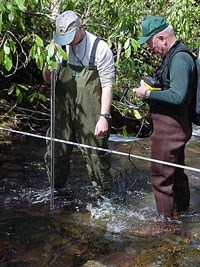
Kent Cave Photo
The cool, clear waters in Great Smoky Mountains National Park's streams appear to be pristine. But are they? Water quality affects many aquatic animals found in the Great Smoky Mountains, such as brook trout, salamanders and frogs. It can also affect non-aquatic species, such as birds who find their source of food in park streams. Since 1991, scientists in the park have been collecting bi-monthly water samples to evaluate water temperature, the amount of dissolved oxygen and which metals and chemicals are dissolved in park waters, the acidity of the water and how well the water can resist changes in acidity (pH) levels. Air Quality, Acid Rain and Excessive Nitrogen The park's water quality is directly affected by the park's air quality. Pollutants, like sulfate nitrate and mercury, from urban and industrial sites and power plants can be found in the park's air. These pollutants are deposited on leaves, soil and other surfaces within the park, and then are washed into park streams during rainstorms. In fact, the equivalent of 200 train cars of sulfuric acid falls over park surfaces each year! Acid rain, also called acid deposition, is rainfall that has been mixed with chemicals and gases to become more acidic than normal. The main gas contributors to acid rain are sulfuric acid (produced by coal burning industries) and nitric acid or nitrogen (produced by automobiles). Acid rain can leach elements found in the soil, such as nitrogen, into the water causing the stream to become more acidic. 
NPS Photo The acidity (pH) level in streams is very important when determining water quality. The acidity of water is measured using the pH system, which ranges from 0-14, with 7 being "neutral." The lower the numbers are, the more acidic the stream is. Knowing the pH level in streams helps scientists to determine the amount of nutrients that can be dissolved in the water and the amount of nutrients that can be used as food by aquatic species. A lower pH level, meaning the stream is more acidic than normal, can also cause metals to leach out of the soil, making the stream toxic to the animal species found there. The Tennessee Department of Environment and Conservation has listed 41 miles of park streams as having a very low pH level (very acidic) and consider them to be impaired. An impaired stream means that the stream is polluted and has failed state water standards. All streams in the park are more acidic than they were 20 years ago. Although the air quality of the park is improving, it will take over 30 years for the water quality to improve. Park soils hold chemicals and gases accumulated from years of acid deposition and will continue to release these stored elements into the surrounding rivers and streams for many years to come, causing further deterioration of the water quality. When a stream has a pH level below 6.0, the stream is less able to support sensitive aquatic species such as brook trout, mayflies, caddisflies and salamanders. In fact, acidic streams are suspected to be the main cause for the decline of the native brook trout population in the park. Gills and reproduction systems in aquatic species are damaged by the acidic water. Acidity also affects amphibian populations because their skin is very sensitive to the water pollutants. Learn more about acid deposition in the park.
Learn the impacts of acidosis on Southern Appalachian Brook Trout.
Temperature and Dissolved Oxygen in Streams The temperature of water has a large influence on aquatic animal, insect and plant species because it determines the types of species that can survive in the stream. Each species has a specific water temperature range in which they can survive. Temperature also affects the amount of dissolved oxygen held in a stream. Warm water holds less dissolved oxygen than cool water does, and may not contain the amount of dissolved oxygen that a species needs to survive. Park streams are currently cold and fast moving with a lot of dissolved oxygen, but this may change in the future due to rising air temperatures and continuing acid deposition. 
NPS Photo National Park Service Position Learn about another water quality problem and efforts to study it in the Smokies: mercury contamination. |
Last updated: November 7, 2019
